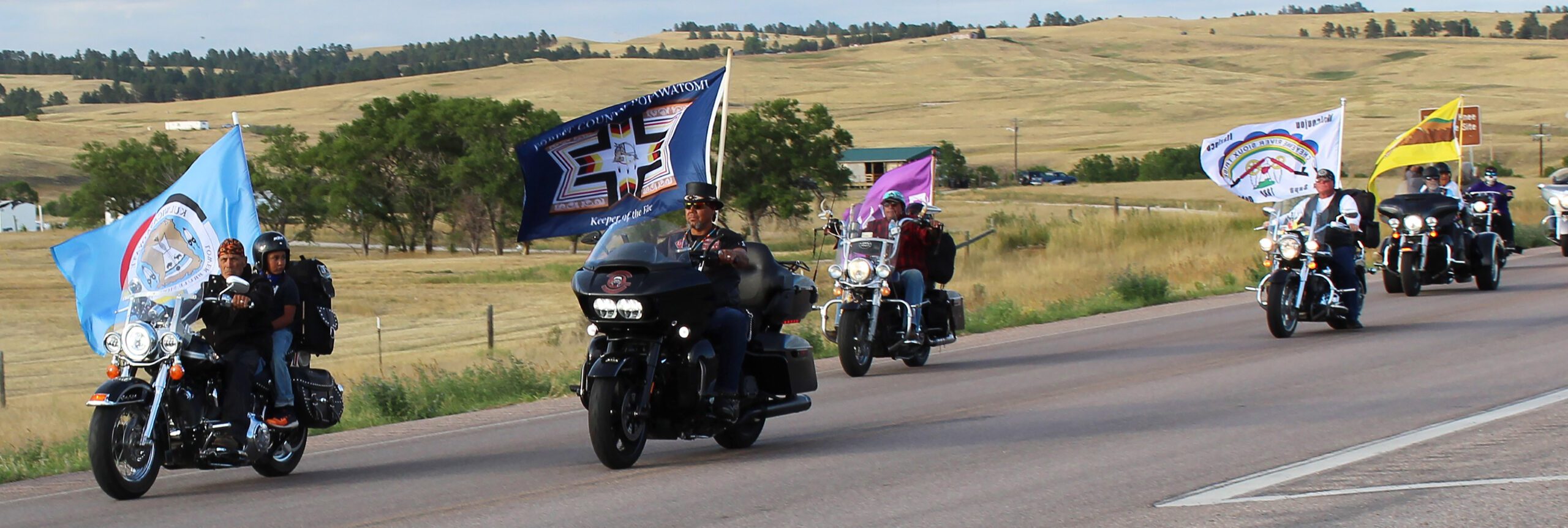They rode with a mission

Native bikers carry flags from the Kul Wicasa Nation, Potawatami Nation. Iroquois Nation, Cheyenne River Sioux Tribe and Lumbee Nation in the Wounded Knee Memorial Run.
WOUNDED KNEE – On Saturday evening, August 5 one could hear the low throaty growl of motorcycle engines coming from a distance. As the riders approached the Wounded Knee massacre site the sounds of their engines turned to a roar. A roar that reminded onlookers that these bikers rode with a mission – a mission to preserve the memory of the innocent Lakota People who suffered and died on December 29, 1890.
As they drove onto the Wounded Knee site, echoes of drumbeats reverberated through the hillsides stained with the bloodshed of the followers of Hehaka Gleska (Spotted Elk) also known as Si Tanka or Big Foot. In December of 1890 Hehaka Gleska and a group of ghost dancers had left the Cheyenne River Indian Reservation shortly after Hunkpapa Itancun Tatanka Iyotaka (Chief Sitting Bull) was killed up north on the Standing Rock Reservation.
The U.S. government had ordered all the Chiefs into the agencies as fear of an uprising grew because the Lakota were practicing the Ghost Dance. Tatanka Iyotaka’s family and other Ghost Dancers had left Standing Rock to seek refuge with their Mnicoujou relatives at Cherry Creek. According to many oral accounts, the Ghost dancers then left to join the Oglala Ghost Dancers, who were held up at Stronghold Table in the Badlands. But they would never make it as they were intercepted by Colonel Forsythe and the Seventh Cavalry who had been camped at Red Cloud Agency for two weeks awaiting word of movement of the Ghost Dancers.
As the Wounded Knee Memorial riders thundered onto the Massacre site, they carried flags representing their respective Tribal Nations, including the Lumbee Nation of North Carolina, the Potawatomi Nation of Shawnee Oklahoma, the Iroquois Nation of New York, Kul Wicasa from Lower Brule, the Sisseton Wahpeton Oyate, the Cheyenne River Sioux Tribe, the Oglala Lakota Nation, the Standing Rock Sioux Tribe and the Rosebud Sioux Tribe.
The Wounded Knee Memorial Riders lined their bikes along the highway, then dismounted to begin their trek up the hillside to the mass grave where more than 300 Hunkpapa and Mnicoujou men, women and children, slaughtered near Čhaŋkpé Ópi Wakpála (Wounded Knee Creek), are buried.
More than a hundred Tribesmen and women marched carrying tribal flags and staffs, some donning war bonnets, decked out in their biker leathers and emblems, all resolute to the mission of paying homage to the ancestors through prayer and ceremony.
Once they reached the Wounded Knee burial site they sang a Lakota memorial song as the smoke of Peji Hota (sage) lifted up their prayers to Tunkasila. They had accomplished their mission.
After the ceremony, riders were invited to the Manderson Community to enjoy an evening meal and a chance to rest after their 300 hundred mile trek.
The Wounded Knee Memorial Run, organized by Lakota Riders Dave Janis and Roger White, is an annual event that coincides with the Sturgis Motorcycle Rally and brings together hundreds of tribal riders from across the U.S. and Canada.
This year’s Run began Friday Aug, 6 at Prairie Knights Casino near Fort Yates, ND. with an overnight stop in Eagle Butte. On Saturday they rode from Eagle Butte to the burial site of the Wounded Knee massacre.
The first days ride was dedicated as a memoriam to LaDonna Brave Bull Allard, a citizen of the Standing Rock Sioux Tribe, who led the Dakota Access Pipeline protest. The second day of the ride was dedicated to Cheyenne River Sioux Tribe Matriarch Marcella LeBeau, an activist and Wounded Knee Survivor descendant.
Among the riders were other descendants, Bob Walters, Vice-Chairman of the Cheyenne River Sioux Tribe who carried the CRST Flag, Joseph McNeil, great-great grandson of Tatanka Iyotaka, rode with his wife Sheridan, Jackie Two Bears and the Wilkinson brothers.
Also riding to honor the ancestors, representing the Navajo Nation were Thomas and Freda Tsosie bikers from Arizona and Ray and Lavina Benally from Church Rock, New Mexico.
“We usually come up from Phoenix and we have been riding every year since 2003,” said Freda Tsosie and that her husband has offered prayers at the Wounded Knee Burial site all those years.
“Wovoka was a false prophet who mislead the people,” Thomas Benally said and that Wovoka misinterpreted the Bible which led people into believing a revival of the old ways would happen if they danced, a dance that led to their death.
(Contact Ernestine Anunkasan Hupa at cahunpigiwin@gmail.com)
Native bikers carry flags from the Kul Wicasa Nation, Potawatami Nation. Iroquois Nation, Cheyenne River Sioux Tribe and Lumbee Nation in the Wounded Knee Memorial Run.
The post They rode with a mission first appeared on Native Sun News Today.
